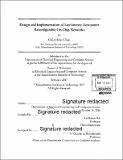Design and implementation of low-latency, low-power reconfigurable on-chip networks
Author(s)
Chen, Chia-Hsin, Ph. D. Massachusetts Institute of Technology
DownloadFull printable version (27.97Mb)
Other Contributors
Massachusetts Institute of Technology. Department of Electrical Engineering and Computer Science.
Advisor
Li-Shiuan Peh.
Terms of use
Metadata
Show full item recordAbstract
In this dissertation, I tackle large, low-latency, low-power on-chip networks. I focus on two key challenges in the realization of such NoCs in practice: (1) the development of NoC design toolchains that can ease and automate the design of large-scale NoCs, paving the way for advanced ultra-low-power NoC techniques to be embedded within many-core chips, and (2) the design and implementation of chip prototypes that demonstrate ultralow- latency, low-power NoCs, enabling rigorous understanding of the design tradeoff of such NoCs. I start off by presenting DSENT (joint work), a timing, area and power evaluation toolchain that supports flexibility in modeling while ensuring accuracy, through a technology-portable library of standard cells [108]. DSENT enables rigorous design space exploration for advanced technologies, and have been shown to provide fast and accurate evaluation of emerging opto-electronics. Next, low-swing signaling has been shown to substantially reduce NoC power, but requires custom circuit design in the past. I propose a toolchain that automates the embedding of low-swing cells into the NoC datapath, paving the way for low-swing signaling to be part of future many-core chips [17]. Third, clockless repeated links have been shown to be embeddable within a NoC datapath, allowing packets to go from source to destination cores without being latched at intermediate routers. I propose SMARTapp, a design that leverages theses clockless repeaters for configuration of a NoC into customized topologies tailored for each applications, and present a synthesis toolchain that takes each SoC application as input, and synthesize a NoC configured for that application, generating RTL to layout [18]. The thesis next presents two chip prototypes that I designed to obtain on-depth understanding of the practical implementation costs and tradeoffs of high-level architectural ideas. The SMART NoC chip is a 3 x 3 mm2 chip in 32 nm SOI realizing traversal of 7 hops within a cycle at 548 MHz, dissipating 1.57 to 2.53 W. It enables a rigorous understanding of the tradeoffs between router clock frequency, network latency and throughput, and is a demonstration of the proposed synthesis toolchain. The SCORPIO 36-core chip (joint work) is an 11 x 13 mm2 chip in 45 nm SOI demonstrating snoopy coherence on a scalable ordered mesh NoC, with the NoC taking just 19 % of tile power and 10 % of tile area [19, 28].
Description
Thesis: Ph. D., Massachusetts Institute of Technology, Department of Electrical Engineering and Computer Science, 2017. Cataloged from PDF version of thesis. Includes bibliographical references (pages [159]-187).
Date issued
2017Department
Massachusetts Institute of Technology. Department of Electrical Engineering and Computer SciencePublisher
Massachusetts Institute of Technology
Keywords
Electrical Engineering and Computer Science.